23.6: Preserving Biodiversity
- Page ID
- 122265
\( \newcommand{\vecs}[1]{\overset { \scriptstyle \rightharpoonup} {\mathbf{#1}} } \)
\( \newcommand{\vecd}[1]{\overset{-\!-\!\rightharpoonup}{\vphantom{a}\smash {#1}}} \)
\( \newcommand{\dsum}{\displaystyle\sum\limits} \)
\( \newcommand{\dint}{\displaystyle\int\limits} \)
\( \newcommand{\dlim}{\displaystyle\lim\limits} \)
\( \newcommand{\id}{\mathrm{id}}\) \( \newcommand{\Span}{\mathrm{span}}\)
( \newcommand{\kernel}{\mathrm{null}\,}\) \( \newcommand{\range}{\mathrm{range}\,}\)
\( \newcommand{\RealPart}{\mathrm{Re}}\) \( \newcommand{\ImaginaryPart}{\mathrm{Im}}\)
\( \newcommand{\Argument}{\mathrm{Arg}}\) \( \newcommand{\norm}[1]{\| #1 \|}\)
\( \newcommand{\inner}[2]{\langle #1, #2 \rangle}\)
\( \newcommand{\Span}{\mathrm{span}}\)
\( \newcommand{\id}{\mathrm{id}}\)
\( \newcommand{\Span}{\mathrm{span}}\)
\( \newcommand{\kernel}{\mathrm{null}\,}\)
\( \newcommand{\range}{\mathrm{range}\,}\)
\( \newcommand{\RealPart}{\mathrm{Re}}\)
\( \newcommand{\ImaginaryPart}{\mathrm{Im}}\)
\( \newcommand{\Argument}{\mathrm{Arg}}\)
\( \newcommand{\norm}[1]{\| #1 \|}\)
\( \newcommand{\inner}[2]{\langle #1, #2 \rangle}\)
\( \newcommand{\Span}{\mathrm{span}}\) \( \newcommand{\AA}{\unicode[.8,0]{x212B}}\)
\( \newcommand{\vectorA}[1]{\vec{#1}} % arrow\)
\( \newcommand{\vectorAt}[1]{\vec{\text{#1}}} % arrow\)
\( \newcommand{\vectorB}[1]{\overset { \scriptstyle \rightharpoonup} {\mathbf{#1}} } \)
\( \newcommand{\vectorC}[1]{\textbf{#1}} \)
\( \newcommand{\vectorD}[1]{\overrightarrow{#1}} \)
\( \newcommand{\vectorDt}[1]{\overrightarrow{\text{#1}}} \)
\( \newcommand{\vectE}[1]{\overset{-\!-\!\rightharpoonup}{\vphantom{a}\smash{\mathbf {#1}}}} \)
\( \newcommand{\vecs}[1]{\overset { \scriptstyle \rightharpoonup} {\mathbf{#1}} } \)
\( \newcommand{\vecd}[1]{\overset{-\!-\!\rightharpoonup}{\vphantom{a}\smash {#1}}} \)
\(\newcommand{\avec}{\mathbf a}\) \(\newcommand{\bvec}{\mathbf b}\) \(\newcommand{\cvec}{\mathbf c}\) \(\newcommand{\dvec}{\mathbf d}\) \(\newcommand{\dtil}{\widetilde{\mathbf d}}\) \(\newcommand{\evec}{\mathbf e}\) \(\newcommand{\fvec}{\mathbf f}\) \(\newcommand{\nvec}{\mathbf n}\) \(\newcommand{\pvec}{\mathbf p}\) \(\newcommand{\qvec}{\mathbf q}\) \(\newcommand{\svec}{\mathbf s}\) \(\newcommand{\tvec}{\mathbf t}\) \(\newcommand{\uvec}{\mathbf u}\) \(\newcommand{\vvec}{\mathbf v}\) \(\newcommand{\wvec}{\mathbf w}\) \(\newcommand{\xvec}{\mathbf x}\) \(\newcommand{\yvec}{\mathbf y}\) \(\newcommand{\zvec}{\mathbf z}\) \(\newcommand{\rvec}{\mathbf r}\) \(\newcommand{\mvec}{\mathbf m}\) \(\newcommand{\zerovec}{\mathbf 0}\) \(\newcommand{\onevec}{\mathbf 1}\) \(\newcommand{\real}{\mathbb R}\) \(\newcommand{\twovec}[2]{\left[\begin{array}{r}#1 \\ #2 \end{array}\right]}\) \(\newcommand{\ctwovec}[2]{\left[\begin{array}{c}#1 \\ #2 \end{array}\right]}\) \(\newcommand{\threevec}[3]{\left[\begin{array}{r}#1 \\ #2 \\ #3 \end{array}\right]}\) \(\newcommand{\cthreevec}[3]{\left[\begin{array}{c}#1 \\ #2 \\ #3 \end{array}\right]}\) \(\newcommand{\fourvec}[4]{\left[\begin{array}{r}#1 \\ #2 \\ #3 \\ #4 \end{array}\right]}\) \(\newcommand{\cfourvec}[4]{\left[\begin{array}{c}#1 \\ #2 \\ #3 \\ #4 \end{array}\right]}\) \(\newcommand{\fivevec}[5]{\left[\begin{array}{r}#1 \\ #2 \\ #3 \\ #4 \\ #5 \\ \end{array}\right]}\) \(\newcommand{\cfivevec}[5]{\left[\begin{array}{c}#1 \\ #2 \\ #3 \\ #4 \\ #5 \\ \end{array}\right]}\) \(\newcommand{\mattwo}[4]{\left[\begin{array}{rr}#1 \amp #2 \\ #3 \amp #4 \\ \end{array}\right]}\) \(\newcommand{\laspan}[1]{\text{Span}\{#1\}}\) \(\newcommand{\bcal}{\cal B}\) \(\newcommand{\ccal}{\cal C}\) \(\newcommand{\scal}{\cal S}\) \(\newcommand{\wcal}{\cal W}\) \(\newcommand{\ecal}{\cal E}\) \(\newcommand{\coords}[2]{\left\{#1\right\}_{#2}}\) \(\newcommand{\gray}[1]{\color{gray}{#1}}\) \(\newcommand{\lgray}[1]{\color{lightgray}{#1}}\) \(\newcommand{\rank}{\operatorname{rank}}\) \(\newcommand{\row}{\text{Row}}\) \(\newcommand{\col}{\text{Col}}\) \(\renewcommand{\row}{\text{Row}}\) \(\newcommand{\nul}{\text{Nul}}\) \(\newcommand{\var}{\text{Var}}\) \(\newcommand{\corr}{\text{corr}}\) \(\newcommand{\len}[1]{\left|#1\right|}\) \(\newcommand{\bbar}{\overline{\bvec}}\) \(\newcommand{\bhat}{\widehat{\bvec}}\) \(\newcommand{\bperp}{\bvec^\perp}\) \(\newcommand{\xhat}{\widehat{\xvec}}\) \(\newcommand{\vhat}{\widehat{\vvec}}\) \(\newcommand{\uhat}{\widehat{\uvec}}\) \(\newcommand{\what}{\widehat{\wvec}}\) \(\newcommand{\Sighat}{\widehat{\Sigma}}\) \(\newcommand{\lt}{<}\) \(\newcommand{\gt}{>}\) \(\newcommand{\amp}{&}\) \(\definecolor{fillinmathshade}{gray}{0.9}\)Preserving biodiversity is an extraordinary challenge that must be met by greater understanding of biodiversity itself, changes in human behavior and beliefs, and various preservation strategies. Today, the main efforts to preserve biodiversity involve legislative approaches to regulate human and corporate behavior, setting aside protected areas, and habitat restoration.
Changing Human Behavior
Legislation has been enacted to protect species throughout the world. The legislation includes international treaties as well as national and state laws. The Convention on International Trade in Endangered Species of Wild Fauna and Flora (CITES) treaty came into force in 1975. The treaty, and the national legislation that supports it, provides a legal framework for preventing approximately 35,000 “listed” species from being transported across nations’ borders, thus protecting them from being caught or killed when the purpose involves international trade. Species can be listed in one of three CITES appendices (Figure \(\PageIndex{1}\)). The treaty is limited in its reach because it only deals with international movement of organisms or their parts. It is also limited by various countries’ ability or willingness to enforce the treaty and supporting legislation. The illegal trade in organisms and their parts is probably a market in the hundreds of millions of dollars. Illegal wildlife trade is monitored by another non-profit: Trade Records Analysis of Flora and Fauna in Commerce (TRAFFIC).

Figure \(\PageIndex{1}\): Big-leaf mahogany (Swietenia macrophylla) timber is used to make furniture, musical instruments, boats, and other products. It listed in CITES Appendix II, meaning that it is regulated. Specifically, a permit is required to ship big-leaf mahogany timber. Image by Forest and Kim Starr (CC-BY).
Within many countries there are laws that protect endangered species and that regulate hunting and fishing. In the United States, the Endangered Species Act (ESA) was enacted in 1973. When an at-risk species is listed by the Act, the U.S. Fish & Wildlife Service is required by law to develop a management plan to protect the species and bring it back to sustainable numbers. The Act, and others like it in other countries, is a useful tool, but it suffers because it is often difficult to get a species listed or to get an effective management plan in place once a species is listed. The ESA does not automatically protect species categorized as threatened on the IUCN Red List. Instead, the U.S. Fish and Wildlife Service (FWS), which enforces the ESA, assesses candidates for protected status as threatened or endangered (Figure \(\PageIndex{2}\)). Consideration of candidate species can be initiated by the FWS itself or at the request of the public. Through the Species Status Assessment Framework, the FWS compiles biological data, such as habitat and population information and current threats to the species. This biological data is used to inform decisions. Additionally, species may be controversially taken off the list without necessarily having had a change in their situation. More fundamentally, the approach to protecting individual species rather than entire ecosystems is both inefficient and focuses efforts on a few highly visible and often charismatic species, perhaps at the expense of other species that go unprotected. At the same time, the ESA has a critical habitat provision outlined in the recovery mechanism that may benefit species other than the one targeted for management.
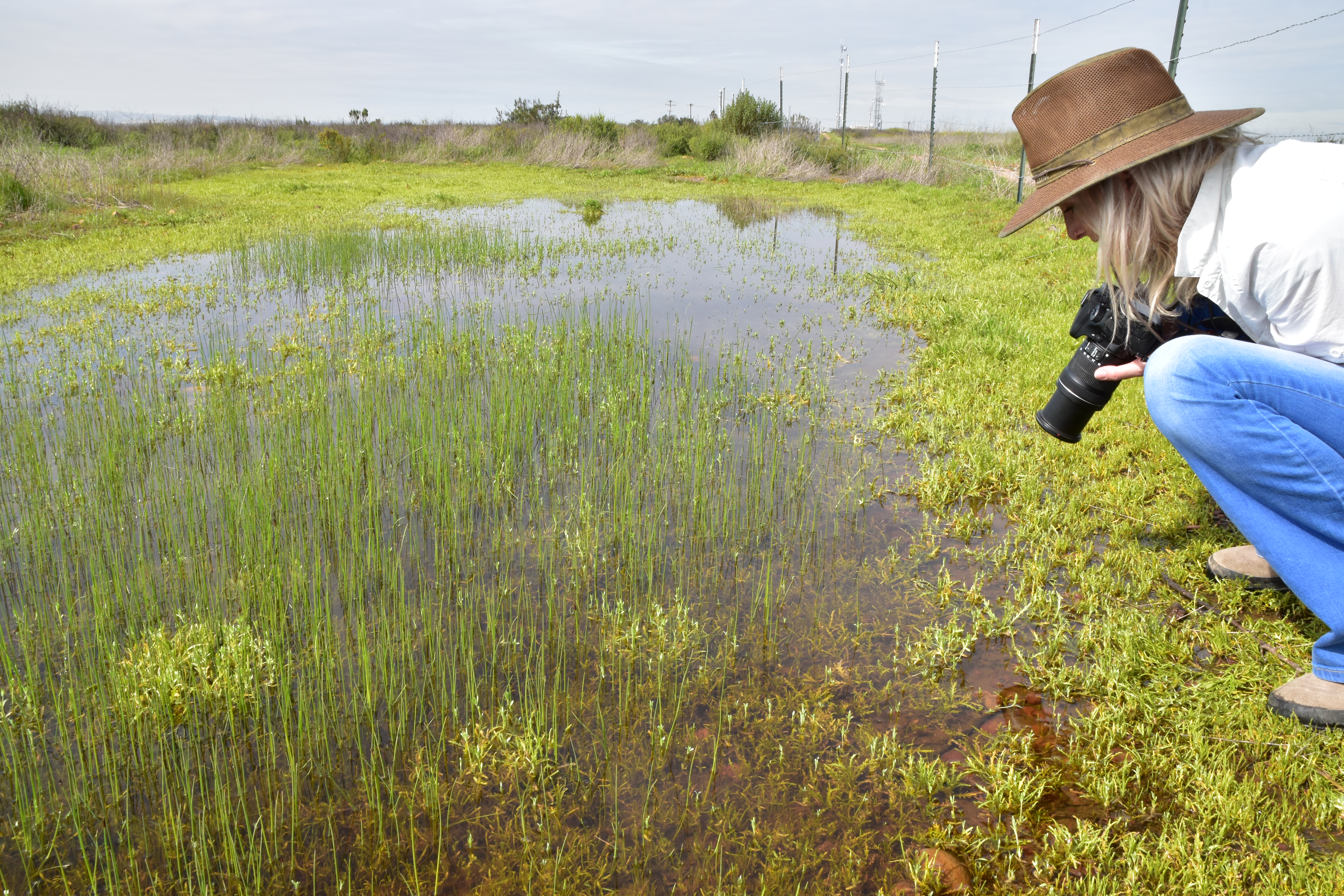
Figure \(\PageIndex{2}\): Public Affairs Specialist for the U.S. Fish and Wildlife Service, Joanna Gilkeson, takes photos of federally endangered San Diego fairy shrimp in a vernal pool in Otay Mesa, California. Vernal pools are shallow seasonal ponds, and vernal pool species are uniquely adapted to changes in water availability. Image by Maideline Sanchez/USFWS (public domain).
The 1972 Marine Mammals Protection Act prohibits the “take” of marine mammals—including harassment, hunting, capturing, collecting, or killing—in U.S. waters and by U.S. citizens on the high seas. The act also makes it illegal to import marine mammals and marine mammal products into the United States without a permit. State laws can also aid in conservation. Through California Endangered Species Act (CESA), originally passed in 1970 and subsequently amended, the California Fish and Game Commission assesses species to be listed as threatened or endangered by the state. A listed species, or any part or product of the plant or animal, may not be imported into the state, exported out of the state, “taken” (killed), possessed, purchased, or sold without proper authorization. Note that endangered is a subcategory of threatened on the Red List, but for ESA and CESA, threatened and endangered are separate categories, with the latter representing at the greater risk of extinction.
The Migratory Bird Treaty Act (MBTA) is an agreement between the United States and Canada that was signed into law in 1918 in response to declines in North American bird species caused by hunting. The Act now lists over 800 protected species. It makes it illegal to disturb or kill the protected species or distribute their parts (much of the hunting of birds in the past was for their feathers). Examples of protected species include northern cardinals, the red-tailed hawk, and the American black vulture.
Climate change is expected to be a major driver of biodiversity loss. Many governments are concerned about the effects of anthropogenic global warming, primarily on their economies and food resources. Because greenhouse gas emissions do not respect national boundaries, the effort to curb them is international. The international response to global warming has been mixed. The Kyoto Protocol, an international agreement that came out of the United Nations Framework Convention on Climate Change that committed countries to reducing greenhouse gas emissions by 2012, was ratified by some countries, but spurned by others. Two countries that were especially important in terms of their potential impact that did not ratify the Kyoto protocol were the United States and China. The United States rejected it as a result of a powerful fossil fuel industry, while China did so because of a concern that it would stifle the nation’s growth. Some goals for reduction in greenhouse gasses were met and exceeded by individual countries, but worldwide, the effort to limit greenhouse gas production is not succeeding. The intended replacement for the Kyoto Protocol has not materialized because governments cannot agree on timelines and benchmarks. Meanwhile, climate scientists predict the resulting costs to human societies and biodiversity will be high. A renegotiated 2016 treaty, called the Paris Agreement, once again brought nations together to take meaningful action on climate change. But like before, some nations are reluctant to participate.
Conservation in Preserves
As already mentioned, the private non-profit sector plays a large role in the conservation effort both in North America and around the world. The approaches range from species-specific organizations to the broadly focused IUCN and TRAFFIC. The Nature Conservancy takes a novel approach. It purchases land and protects it in an attempt to set up preserves for ecosystems. Ultimately, human behavior will change when human values change. At present, the growing urbanization of the human population is a force that poses challenges to the valuing of biodiversity.
Establishment of wildlife and ecosystem preserves is one of the key tools in conservation efforts (Figure \(\PageIndex{3}\)). A preserve is an area of land set aside with varying degrees of protection for the organisms that exist within the boundaries of the preserve. Governments or private organizations establish nature preserves. Preserves can be effective in the short term for protecting both species and ecosystems, but they face challenges that scientists are still exploring to strengthen their viability as long-term solutions.
Due to the way protected lands are allocated (they tend to contain less economically valuable resources rather than being set aside specifically for the species or ecosystems at risk) and the way biodiversity is distributed, determining a target percentage of land or marine habitat that should be protected to maintain biodiversity levels is challenging. The IUCN World Parks Congress estimated that 11.5 percent of Earth’s land surface was covered by preserves of various kinds in 2003. This area is greater than previous goals; however, it only represents 9 out of 14 recognized major biomes. Research has shown that 12 percent of all species live only outside preserves; these percentages are much higher when only threatened species and high quality preserves are considered. For example, high quality preserves include only about 50 percent of threatened amphibian species. The conclusion must be that either the percentage of area protected must increase, or the percentage of high quality preserves must increase, or preserves must be targeted with greater attention to biodiversity protection. Researchers argue that more attention to the latter solution is required.
It is important to protect natural areas for several reasons. Some people feel a cultural or spiritual connection to the wilderness. Every year, millions of people visit recreational lands such as parks and wilderness areas to experience attractions of the great outdoors: hiking among the giant sequoias in California, traveling on a photo safari in Kenya or just picnicking at a local county park. Besides providing people with obvious health benefits and aesthetic pleasures, recreational lands also generate considerable tourist money for government and local economies. Outdoor recreation activities such as hiking and camping benefit tourist industries and manufacturers of outdoor clothes and equipment.
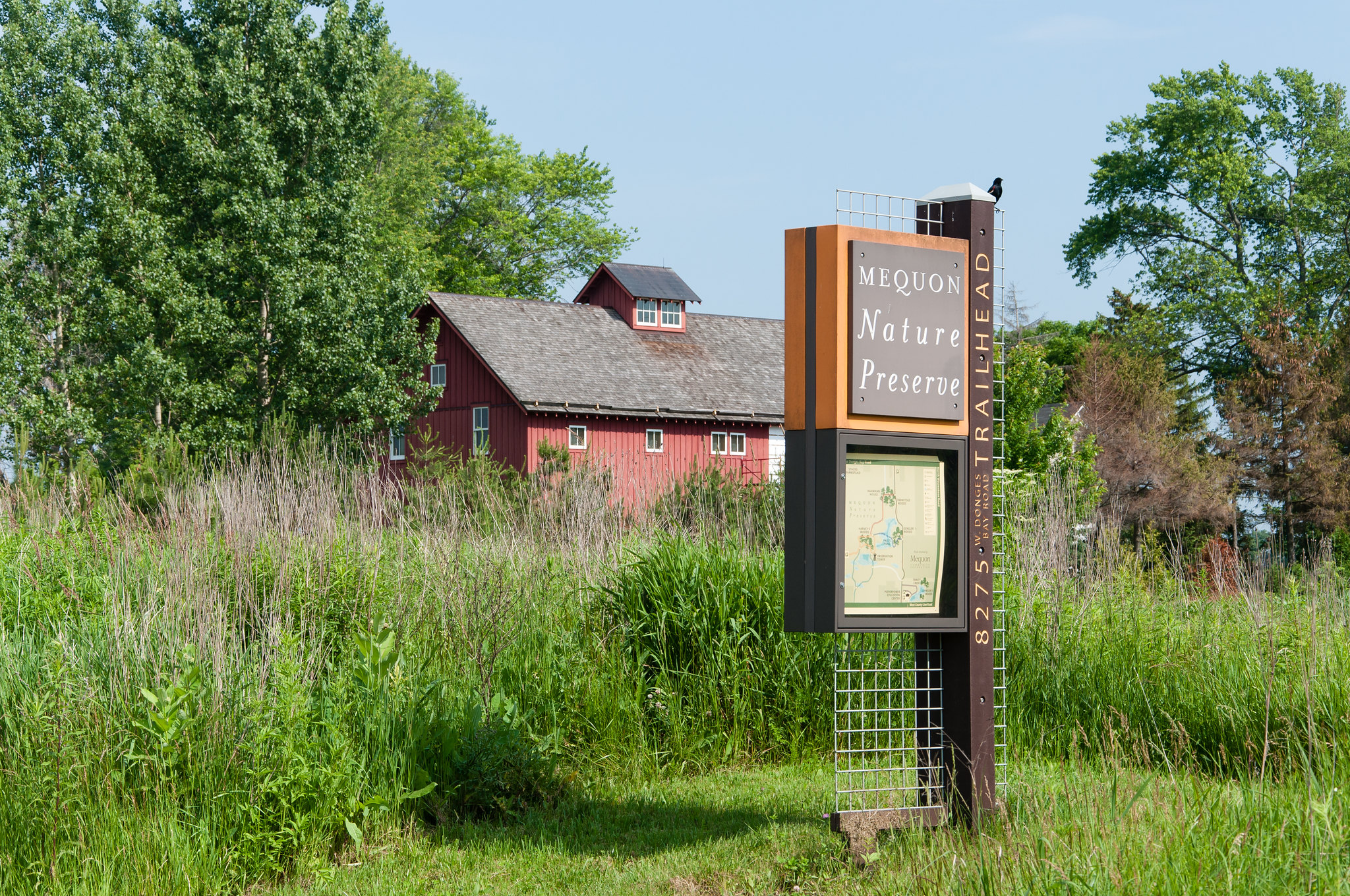
Figure \(\PageIndex{3}\): Mequon Nature Preserve in Wisconsin. Image by Jennifer Tomaloff (CC BY-NC-SA 2.0).
Preserve Design
There has been extensive research into optimal preserve designs for maintaining biodiversity. The fundamental principle behind much of the research has been the seminal theoretical work of Robert H. MacArthur and Edward O. Wilson published in 1967 on island biogeography.1 This work sought to understand the factors affecting biodiversity on islands. The fundamental conclusion was that biodiversity on an island was a function of the origin of species through migration, speciation, and extinction on that island. Islands farther from a mainland are harder to get to, so migration is lower and the equilibrium number of species is lower. Within island populations, evidence suggests that the number of species gradually increases to a level similar to the numbers on the mainland from which the species is suspected to have migrated. In addition, smaller islands are harder to find, so their immigration rates for new species are lower. Smaller islands are also less geographically diverse so there are fewer niches to promote speciation. And finally, smaller islands support smaller populations, so the probability of extinction is higher. As islands get larger, the number of species accelerates, although the effect of island area on species numbers is not a direct correlation.
Conservation preserves can be seen as “islands” of habitat within “an ocean” of non-habitat. In general, large preserves are better because they support more species, including species with large home ranges; they have more core area of optimal habitat for individual species; they have more niches to support more species; and they attract more species because they can be found and reached more easily. One large preserve is better than the same area of several smaller preserves because there is more core habitat unaffected by less hospitable ecosystems outside the preserve boundary. For this same reason, preserves in the shape of a square or circle will be better than a preserve with many thin “arms.” If preserves must be smaller, then providing wildlife corridors (narrow strips of protected land) between two preserves is important so that species and their genes can move between them. All of these factors are taken into consideration when planning the nature of a preserve before the land is set aside.
For a species to persist in a preserve, the preserve must be large enough. The critical size depends, in part, on the home range that is characteristic of the species. A preserve for wolves, which range hundreds of kilometers, must be much larger than a preserve for butterflies, which might range within ten kilometers during its lifetime. But larger preserves have more core area of optimal habitat for individual species, they have more niches to support more species, and they attract more species because they can be found and reached more easily.
Preserves perform better when there are buffer zones around them of suboptimal habitat. The buffer allows organisms to exit the boundaries of the preserve without immediate negative consequences from predation or lack of resources. One large preserve is better than the same area of several smaller preserves because there is more core habitat unaffected by edges. For this same reason, preserves in the shape of a square or circle will be better than a preserve with many thin “arms.” If preserves must be smaller, then providing wildlife corridors between them so that individuals and their genes can move between the preserves, for example along rivers and streams, will make the smaller preserves behave more like a large one. All of these factors are taken into consideration when planning the nature of a preserve before the land is set aside.
In addition to the physical, biological, and ecological specifications of a preserve, there are a variety of policy, legislative, and enforcement specifications related to uses of the preserve for functions other than protection of species. These can include anything from timber extraction, mineral extraction, regulated hunting, human habitation, and nondestructive human recreation. Many of these policy decisions are made based on political pressures rather than conservation considerations. In some cases, wildlife protection policies have been so strict that subsistence-living indigenous populations have been forced from ancestral lands that fell within a preserve. In other cases, even if a preserve is designed to protect wildlife, if the protections are not or cannot be enforced, the preserve status will have little meaning in the face of illegal poaching and timber extraction. This is a widespread problem with preserves in areas of the tropics.
Limitations on Preserves
Some of the limitations on preserves as conservation tools are evident from the discussion of preserve design. Political and economic pressures typically make preserves smaller, never larger, so setting aside areas that are large enough is difficult. If the area set aside is sufficiently large, there may not be sufficient area to create a buffer around the preserve. In this case, an area on the outer edges of the preserve inevitably becomes a riskier suboptimal habitat for the species in the preserve. Enforcement of protections is also a significant issue in countries without the resources or political will to prevent poaching and illegal resource extraction.
Climate change will create inevitable problems with the location of preserves. The species within them will migrate to higher latitudes as the habitat of the preserve becomes less favorable. Scientists are planning for the effects of global warming on future preserves and striving to predict the need for new preserves to accommodate anticipated changes to habitats; however, the end effectiveness is tenuous since these efforts are prediction based.
Finally, an argument can be made that conservation preserves reinforce the cultural perception that humans are separate from nature, can exist outside of it, and can only operate in ways that do damage to biodiversity. Creating preserves reduces the pressure on human activities outside the preserves to be sustainable and non-damaging to biodiversity. Ultimately, the political, economic, and human demographic pressures will degrade and reduce the size of conservation preserves if the activities outside them are not altered to be less damaging to biodiversity.
Link to Learning

An interactive global data system of protected areas can be found at website. Review data about individual protected areas by location or study statistics on protected areas by country or region.
On an international level, important wilderness lands have been designated by the United Nations through its "Man and the Biosphere Program." This program was established in 1973 to protect examples of major natural regions throughout the world, and provide opportunities for ecological research and education. Biosphere reserves are organized into three interrelated zones: the core area, the buffer zone and the transition area. The core area contains the landscape and ecosystems to be preserved. The buffer zone is an area where activities are controlled to protect the core area. The outer transition area contains a variety of agricultural activities, human settlements and other uses. Local communities, conservation agencies, scientists and private enterprises that have a stake in the management of the region work together to make the reserves work. Mt Kenya in Africa and the Galapagos Islands are examples of wilderness areas protected under this provision.
Types of Protected Areas in the United States
The public lands described below differ in their level of protection. For example, national parks and forests allow camping whereas wildlife refuges place more limitations on human activities. National parks and forests and wildlife refuges can contain wilderness areas.
Wilderness areas, comprise ecosystems in which human activity has not significantly affected the plant and animal populations or their environment. Natural processes predominate. According to the "Wilderness Act of 1964," wilderness areas are defined as being those areas where the nearest road is at least five miles away and where no permanent buildings stand. Activities that could disrupt native species, such as the use of motorized vehicles is prohibited. More than 100 million acres of land are now preserved as wilderness under this act. Sparsely populated Alaska contains the largest chunk of wilderness areas, over half of it. Although wilderness areas are scattered among most of the lower 48 states, the largest percentage is found in the western states. Few undesignated areas in the contiguous states remain that would qualify as wilderness. California contains significant wilderness areas, with over 4 million acres of National Forest Wilderness areas, and 1.5 million acres of mostly desert wilderness in the Mojave Desert National Preserve (Figure \(\PageIndex{4}\)). Wilderness areas provide an essential habitat for a wide array of fish, wildlife, and plants, and are particularly important in protecting endangered species. For scientists, wilderness areas serve as natural laboratories, where studies can be performed that would not be possible in developed areas.
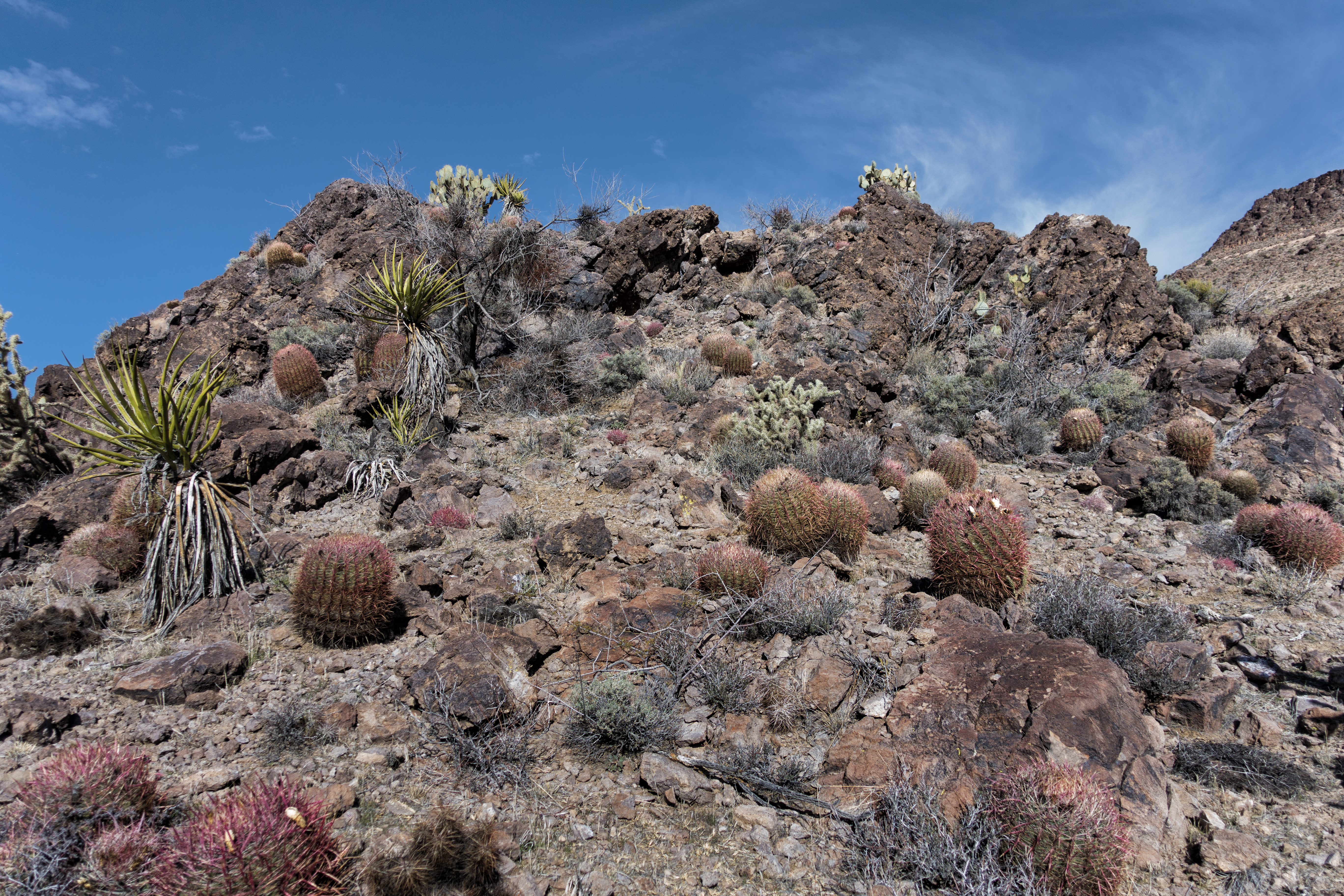
Figure \(\PageIndex{4}\): A variety of unique plant life grows at Mojave Desert National Preserve. Image by John Fowler (CC-BY 2.0).
The United States has set aside more land for public recreational use than any other country. The National Park System manages more than 380 parks, recreation areas, seashores, trails, monuments, memorials, battlefields, and other historic sites. It consists of more than 80 million acres nationwide (Figure \(\PageIndex{5}\)). The largest national park is Wrangell–St. Elias National Park and Preserve in Alaska with over 13 million acres. California has eight national parks: Channel Islands, Death Valley, Joshua Tree, Lassen, Redwood, Sequoia, Kings Canyon, and Yosemite. Many national parks such as Yosemite, Yellowstone and the Grand Canyon are such popular recreation destinations that the ecosystems of those parks are being severely tested by human activities.
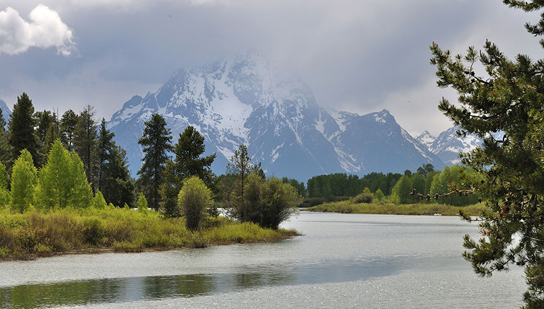
Figure \(\PageIndex{5}\): National parks, such as Grand Teton National Park in Wyoming, help conserve biodiversity (credit: Don DeBold).
Every state has also set aside significant amounts of land for recreational use. The California State Park System manages more than one million acres of parklands including: coastal wetlands, estuaries, scenic coastlines, lakes, mountains and desert areas. California's largest state park is Anza-Borrego Desert State Park, which is the largest state park in the United States with 600,000 acres. The stated mission of the California State Park System is "to provide for the health, inspiration and education of the people of California by helping to preserve the state's extraordinary biological diversity, protecting its most valued natural and cultural resources and creating opportunities for high-quality outdoor recreation". This is the basic goal of all recreational lands: to manage and conserve natural ecosystems, while supporting a sustainable and balanced level of human use of those areas. Unfortunately, it is a goal which is sometimes difficult to achieve due to the increasing popularity and use of recreational lands.
The National Forest System, managed by the U.S. Forest Service (part of the United States Department of Agriculture), consists of more than 170 forestlands and grasslands, which are available for activities such as camping, fishing, hiking and hunting. These are managed as multiple use lands, which balance the needs for recreation, grazing, timber, watershed protection, wildlife and fish, and wilderness. Some examples of national forests are the Sierra National Forest in California and the White Mountain National Forest in New Hampshire. The Coronado National Forest in Arizona is famous for "sky islands", or steep mountain ranges surrounded by low-lying areas. The dramatic increase in elevation is associated with changes in the flora and fauna (Figure \(\PageIndex{6}\)). Explore national forests using this interactive map.
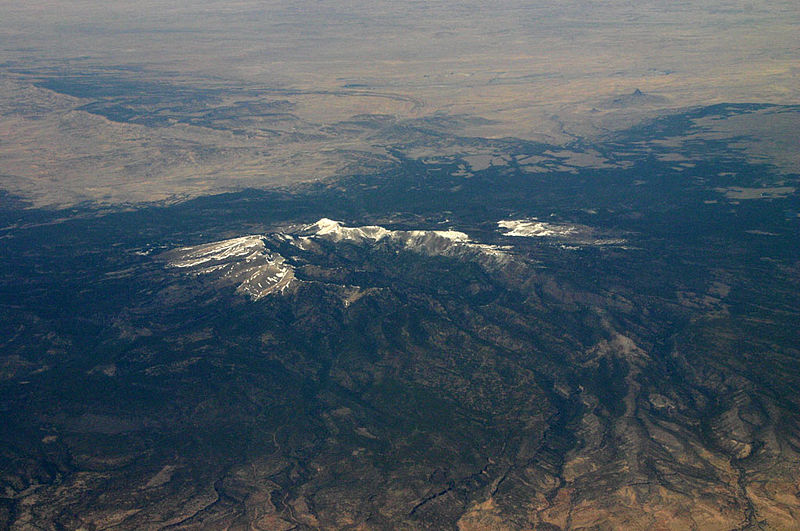
Figure \(\PageIndex{6}\): The Santa Teresa Mountains of the Coronado National Forest form "sky islands." Image by Jstuby (public domain).
The U.S. Fish and Wildlife Service manage more than 500 national wildlife refuges (Figure \(\PageIndex{7}\)), which not only protect animal habitats and breeding areas but also provide recreational facilities. Find a Refuge is an interactive map for locating wildlife refuges.
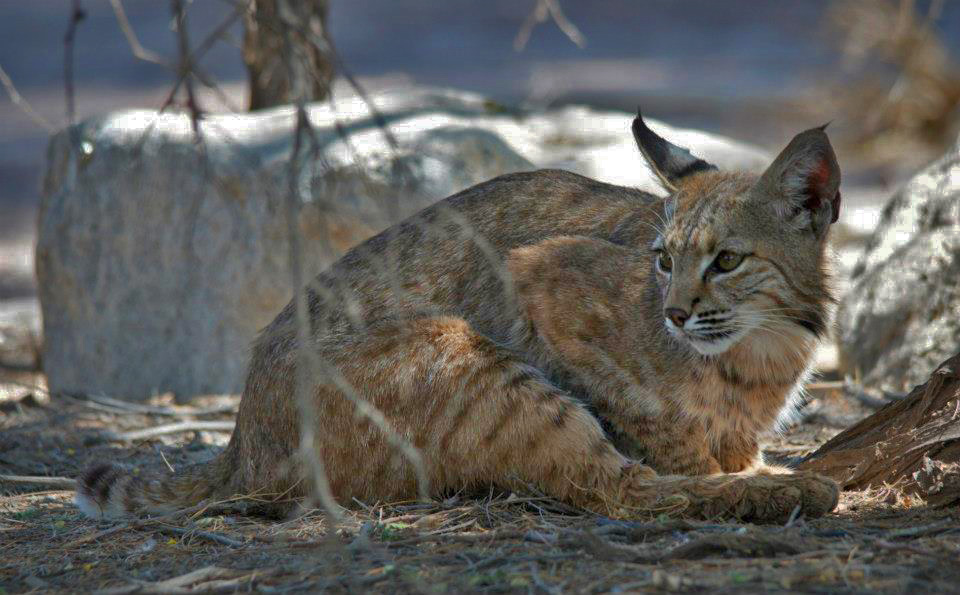
Figure \(\PageIndex{7}\): Bobcat at Sonny Bono National Wildlife Refuge in southern California. Image by Mark Stewart/USFWS (public domain).
Several other types of public lands complement the designated wilderness land system. These include: national forest roadless areas, national trails system, natural research areas and state and private wilderness lands. The national forest roadless areas consist of millions of acres of wild, undeveloped land without roads that exist on National Forest land outside of designated wilderness lands. The "National Trail System," established by Congress in 1968, includes trails in wilderness areas and other public lands. Research Natural Areas located throughout the country on public lands serve as outdoor laboratories to study natural systems. They are intended in part to serve as gene pools for rare and endangered species and as examples of significant natural ecosystems. Some wilderness lands are maintained by states or private organizations. For example, the state of New York has long preserved a region of the Adirondacks as wilderness.
Habitat Restoration, Remediation, and Reclamation
Habitat restoration holds considerable promise as a mechanism for restoring and maintaining biodiversity. Of course once a species has become extinct, its restoration is impossible. However, restoration can improve the biodiversity of degraded ecosystems. Reintroducing wolves, a top predator, to Yellowstone National Park in 1995 led to dramatic changes in the ecosystem that increased biodiversity. The wolves (Figure \(\PageIndex{8}\)) function to suppress elk and coyote populations and provide more abundant resources to the guild of carrion eaters. Reducing elk populations has allowed revegetation of riparian areas, which has increased the diversity of species in that habitat. Decreasing the coyote population has increased the populations of species that were previously suppressed by this predator. The number of species of carrion eaters has increased because of the predatory activities of the wolves. In this habitat, the wolf is a keystone species, meaning a species that is instrumental in maintaining diversity in an ecosystem. Removing a keystone species from an ecological community may cause a collapse in diversity. The results from the Yellowstone experiment suggest that restoring a keystone species can have the effect of restoring biodiversity in the community. Ecologists have argued for the identification of keystone species where possible and for focusing protection efforts on those species; likewise, it also makes sense to attempt to return them to their ecosystem if they have been removed.
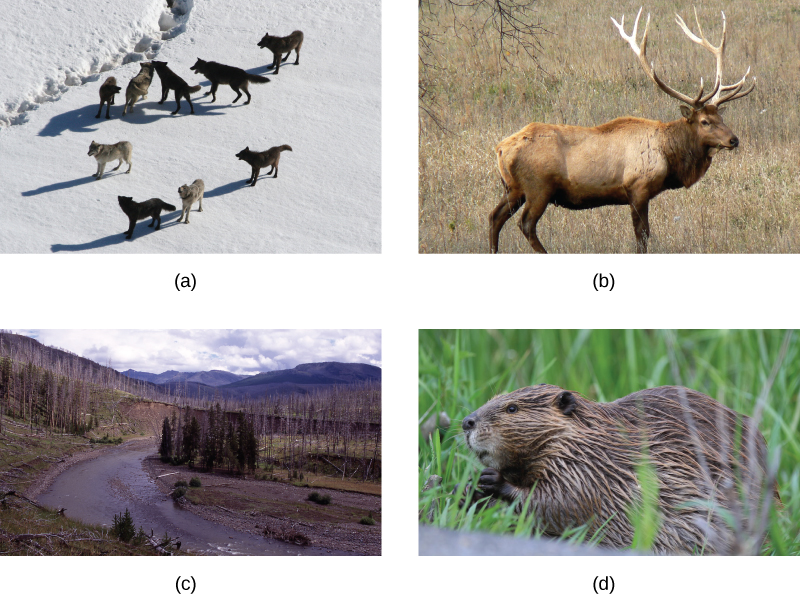
Figure \(\PageIndex{8}\): (a) The Gibbon wolf pack in Yellowstone National Park, March 1, 2007, represents a keystone species. The reintroduction of wolves into Yellowstone National Park in 1995 led to a change in the grazing behavior of (b) elk. To avoid predation, the elk no longer grazed exposed stream and riverbeds, such as (c) the Lamar Riverbed in Yellowstone. This allowed willow and cottonwood seedlings to grow. The seedlings decreased erosion and provided shading to the creek, which improved fish habitat. A new colony of (d) beaver may also have benefited from the habitat change. (credit a: modification of work by Doug Smith, NPS; credit c: modification of work by Jim Peaco, NPS; credit d: modification of work by “Shiny Things”/Flickr).
Other large-scale restoration experiments underway involve dam removal. In the United States, since the mid-1980s, many aging dams are being considered for removal rather than replacement because of shifting beliefs about the ecological value of free-flowing rivers and because many dams no longer provide the benefit and functions that they did when they were first built. The measured benefits of dam removal include restoration of naturally fluctuating water levels (the purpose of dams is frequently to reduce variation in river flows), which leads to increased fish diversity and improved water quality. In the Pacific Northwest, dam removal projects are expected to increase populations of salmon, which is considered a keystone species because it transports key nutrients to inland ecosystems during its annual spawning migrations. In other regions such as the Atlantic coast, dam removal has allowed the return of spawning anadromous fish species (species that are born in fresh water, live most of their lives in salt water, and return to fresh water to spawn). Some of the largest dam removal projects have yet to occur or have happened too recently for the consequences to be measured. The large-scale ecological experiments that these removal projects constitute will provide valuable data for other dam projects slated either for removal or construction.
Besides physical processes, socioeconomic factors must also be considered in a restoration project. Actions of humans have historically been important in shaping ecosystems, and are important in determining the success of restoration efforts. Because the cost to restore an individual site can involve millions of dollars, government support is a necessity.
Danger to human health from both historic and modern pollution requires that cleanup measures be implemented. Remediation is aimed at neutralization, containment, and/or removal of the polluting chemicals. The goal is to prevent the spread of the pollution, or to reduce it to levels that will not appreciably risk human health. Many times, it is physically impossible or financially unfeasible to completely clear all contamination. Often, experts and the public disagree on how clean is clean enough.
Many communities are struggling to find the funds and technological expertise needed to clean up polluted areas. Some settings, such as brownfields, can be remediated fairly easily. Brownfields are abandoned industrial or commercial facilities or blighted urban areas that need to be cleansed of contamination before they can be redeveloped. Other areas, because of their size or the extreme toxicity of their contaminants, require very expensive, complex, and long-term remediation. Many of these have been designated as Superfund sites.
Superfund sites are areas with the most toxic contamination in the United States. The contamination may not only make the site itself too dangerous to inhabit, but often leaks toxic levels of pollutants into the surrounding soil, water, or air. An example of a Superfund site is Love Canal in Niagara Falls, New York (Figure \(\PageIndex{9}\)). The canal was a chemical waste dump for many years, then in the 1950’s was covered with soil and sold to the city. Over time, many homes and a school were built over the former dump. In the 1970’s, heavy rains raised the water table and carried contaminants back to the surface. Residents noticed foul smells, and gardens and trees turned black and died. Soon after, rates of birth defects, cancer, and other illnesses began to rise sharply. In 1977, the State of New York and the federal government began remediation work. Buildings were removed, and all residents were bought out and relocated, contaminated deposits and soils were excavated, and remaining soils and groundwater were treated and sealed off to prevent further spread of the contamination. Remediation activities have now been completed at this site.
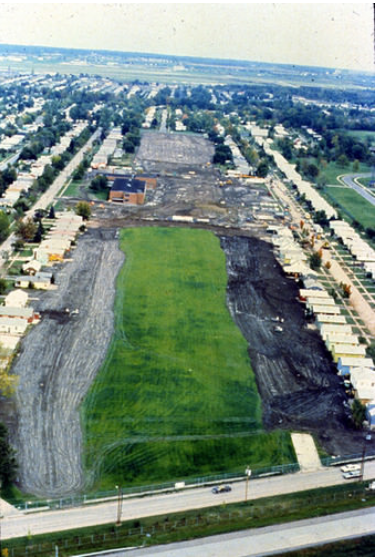
Figure \(\PageIndex{9}\): Love Canal. Source: US Environmental Protection Agency.
The type of pollution and the medium affected (air, water, or soil) determine remediation methods. Methods include incineration, absorption onto carbon, chemical methods, or bioremediation. Bioremediation is the use of plants, bacteria, or fungus to “digest” the contaminant to a non-toxic or less toxic form. All of these methods tend to be expensive and time-consuming.
Reclamation involves salvaging some features of a degraded habitat, but it may not restore the ecosystem fully (Figure \(\PageIndex{10}\)). For example, instead of abandoning a mined area once resources have been collected, it can be reclaimed by planting vegetation, reshaping the landscape, and redirecting water flow. However the reclaimed land still lacks many features of the original ecosystem, such as complex topography, vegetation that took tens or hundreds of years to grow, soil quality, and an intricate network of streams.

Figure \(\PageIndex{10}\): The Seneca Yoast coal once land has been cleared in preparation for mining (left) and after reclamation (right). Image by Peabody Energy, Inc. (CC-BY).
Sometimes, actions can be taken to avoid, reduce or compensate for the effects of environmental damage. Such mitigation efforts have been taken by the Army Corps of Engineers during construction projects. The native plants are removed from a site before construction begins and transplanted at a special holding site. After the construction project is completed, the native plants are replanted using those from the holding site. Another example of mitigation might involve the creation or enhancement of wetlands in one area, in order to compensate for permitted wetland losses in another area. Mitigation often goes hand-in-hand with restoration. Texaco, in conjunction with environmental groups and the United States Fish and Wildlife Service, restored 500 acres of agricultural lands in the lower Mississippi Delta to bottomland hardwoods. Texaco received environmental credits for the mitigating effects of the new woodlands on air quality.
The Role of Captive Breeding
Zoos have sought to play a role in conservation efforts both through captive breeding programs and education (Figure \(\PageIndex{11}\)). The transformation of the missions of zoos from collection and exhibition facilities to organizations that are dedicated to conservation is ongoing and gaining strength. In general, it has been recognized that, except in some specific targeted cases, captive breeding programs for endangered species are inefficient and often prone to failure when the species are reintroduced to the wild. However, captive breeding programs have yielded some success stories, such as the California condor reintroduction to the Grand Canyon and the reestablishment of the Whooping Crane along the Midwest flyway. Unfortunately, zoo facilities are far too limited to contemplate captive breeding programs for the numbers of species that are now at risk. Education is another potential positive impact of zoos on conservation efforts, particularly given the global trend to urbanization and the consequent reduction in contacts between people and wildlife. A number of studies have been performed to look at the effectiveness of zoos on people’s attitudes and actions regarding conservation; at present, the results tend to be mixed.

Figure \(\PageIndex{11}\): Zoos and captive breeding programs help preserve many endangered species, such as this golden lion tamarin (credit: Garrett Ziegler).
Economic Influences on Conservation
Economics greatly impacts conservation success. Short-term profits can incentivize individuals, companies, or governments to harvesting resources at an unsustainable rate and at the expense of ecosystem health. In impoverished regions, compromising habitat to grow high-value crops, such as coffee or oil palms, or poaching endangered species may seem like the only source of income. One solution is debt-for-nature swaps through which one country forgives the debt of another if the latter agrees to protect natural areas. These conservation efforts can provide a new source of income for residents near the protected areas. For example, the United States forgave $20 million in debt from Costa Rica. In exchange, Costa Rica invested in expanding its protected areas and developing the ecotourism industry, which provides jobs to many of its residents (Figure \(\PageIndex{12}\)). Ecotourism involves visiting and enjoying natural areas while minimizing ecological damage. Ecotourism can benefit local economies and alleviate poverty especially if the earnings from it are reinvested into the communities living near tourist destinations. It generates jobs such as park operators, sellers of local crafts, and tour guides.

Figure \(\PageIndex{12}\): A tourist ziplines over the Costa Rican rainforest. Image by Khaufle at the English language Wikipedia (CC-BY-SA).
Supplemental Reading
America's Public Lands Explained. 2016. U.S. Department of the Interior.
References
MacArthur, R.H., & Wilson, E. O. (1967). The theory of island biogeography. Princeton, N.J.: Princeton University Press.
Contributors and Attributions
Modified by Kyle Whittinghill and Melissa Ha from the following sources
- Preserving Biodiversity by OpenStax is licensed under CC BY 4.0 by
Connie Rye (East Mississippi Community College), Robert Wise (University of Wisconsin, Oshkosh), Vladimir Jurukovski (Suffolk County Community College), Jean DeSaix (University of North Carolina at Chapel Hill), Jung Choi (Georgia Institute of Technology), Yael Avissar (Rhode Island College) among other contributing authors. Original content by OpenStax (CC BY 4.0; Download for free at http://cnx.org/contents/185cbf87-c72...f21b5eabd@9.87).
- Threatened and Endangered Species by California Department of Fish and Wildlife (public domain)
- Marine Mammal Protection by NOAA Fisheries (public domain)
- Ecotourism from Life Sciences Grade 10 by Siyavula (licensed under CC-BY)
- Preserving Biodiversity and Case Study - The Love Canal Disaster from Environmental Biology by Matthew R. Fisher (licensed under CC-BY)
- Issues and Opinions, Biological and Land from AP Environmental Science by University of California College Prep, University of California (licensed under CC-BY). Download for free at CNX.
- Multiple Use Lands. 12 May 2015. The United States Department of Justice. Accessed 28 March 2021 (public domain)


